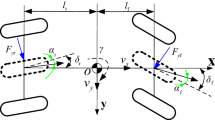Abstract
In this paper, we propose an improved cooperative collision Avoidance (CCA) system based on V2V communication for connected vehicles. To avoid the emergency braking and ensure the driver comfort, the collision can be prevented by not only decelerating the following vehicle, but also allowing the preceding vehicle to accelerate. Two collision avoidance models are thus developed: braking model and acceleration model, which calculate the desired deceleration rate of the following vehicle and the acceleration rate of preceding vehicle at each control time interval. It mainly addresses two issues, firstly, the traditional collision avoidance models mainly rely on emergency braking of the following vehicle, and the spacing will decrease suddenly, so the safety risk to drivers and passengers still exist; secondly, emergency braking always raise the driver discomfort. To address these issues, The improved CCA system is then tested on the platform of Matlab/Simulink embedded with a car simulator package, CarSim. The simulation results show that the improved CCA model can effectively avoid collision and ensure the driver comfort at the same time.
Similar content being viewed by others
References
Baum, D., Hamann, C. D. and Schubert, E. (1997). High performance ACC system based on sensor fusion with distance sensor, image processing unit, and navigation system. Vehicle System Dynamics 28, 6, 327–338.
Chiang, H. H., Wu, B. F., Lee, T. T. and Perng, J. W. (2007). Integrated headway adaptation with collision avoidance system for intelligent vehicles. Systems, Man and Cybernetics, 2007 IEEE Int. Conf. ISIC, 3276–3281.
Frese, C. and Beyerer, J. (2011). A comparison of motion planning algorithms for cooperative collision avoidance of multiple cognitive automobiles. Intelligent Vehicles Symposium (IV), 2011 IEEE, 1156–1162.
Fritz, A. and Schiehlen, W. (1999). Automatic cruise control of a mechatronically steered vehicle convoy. Vehicle System Dynamics 32, 4-5, 331–344.
Han, J. and Park, Y. (2014). Cooperative regenerative braking control for front-wheel-drive hybrid electric vehicle based on adaptive regenerative brake torque optimization using under-steer index. Int. J. Automotive Technology 15, 6, 989–1000.
Huang, C. L., Fallah, Y. P., Sengupta, R. and Krishnan, H. (2011). Intervehicle transmission rate control for cooperative active safety system. IEEE Trans. Intelligent Transportation Systems 12, 3, 645–658.
Hedrick, J. K., Uchanski, M. and Xu. Q. (2001). Enhanced AHS Safety through the Integration of Vehicle Control and Communication. California PATH Research Report, UCB-ITS-PRR-2001-28.
Kim, D. J., Park, K. H. and Bien, Z. (2007). Hierarchical longitudinal controller for rear-end collision avoidance. IEEE Trans. Industrial Electronics 54, 2, 805–817.
Lee, D. H., Bai, S. N. and Kwak, D. Y. (2011). Enhanced selective forwarding scheme for alert message propagation in vehicular ad hoc networks. Int. J. Automotive Technology 12, 2, 251–264.
Lee, J. D., McGehee, D. V., Brown, T. L. and Reyes, M. L. (2002). Collision warning timing, driver distraction, and driver response to imminent rear-end collisions in a high-fidelity driving simulator. The J. Human Factors and Ergonomics Society 44, 2, 314–334.
Nadeem, T., Dashtinezhad, S., Liao, C. and Iftode, L. (2004). Trafficview: Traffic data dissemination using car-to-car communication. ACM SIGMOBILE Mobile Computing and Communications Review 8, 3, 6–19.
National Highway Traffic Safety Administration (2012). Traffic Safety Facts, 2007 Data: Bicyclists and Other Cyclists. DOTHS.810-986.
Rohr, S. N., Lind, R. C., Myers, R. J., Bauson, W. A., Kosiak, W. K. and Yen, H. (2000). An integrated approach to automotive safety systems. SAE Trans. 109, 6, 453–459.
Rezaei, S., Sengupta, R., Krishnan, H., Guan, X. and Bhatia, R. (2010). Tracking the position of neighboring vehicles using wireless communications. Transportation Research Part C 18, 3, 335–350.
Santa, J., Toledo-Moreo, R., Zamora-Izquierdo, M. A., Úbeda, B. and Gómez-Skarmeta, A. F. (2010). An analysis of communication and navigation issues in collision avoidance support systems. Transportation Research Part C 18, 3, 351–366.
Seo, H. S., Jung, J. S. and Lee, S. S. (2014). Network performance analysis and manuever model for overtaking assistant service using wave. Int. J. Automotive Technology 15, 1, 57–64.
Tan, H. S. and Huang, J. (2006). DGPS-based vehicle-tovehicle cooperative collision warning: Engineering feasibility viewpoints. IEEE Trans. Intelligent Transportation Systems 7, 4, 415–428.
Author information
Authors and Affiliations
Corresponding author
Rights and permissions
About this article
Cite this article
Wang, P.W., Wang, L., Li, Y.H. et al. Improved cooperative collision Avoidance (CCA) model considering driver comfort. Int.J Automot. Technol. 16, 989–996 (2015). https://doi.org/10.1007/s12239-015-0101-7
Received:
Revised:
Accepted:
Published:
Issue Date:
DOI: https://doi.org/10.1007/s12239-015-0101-7




